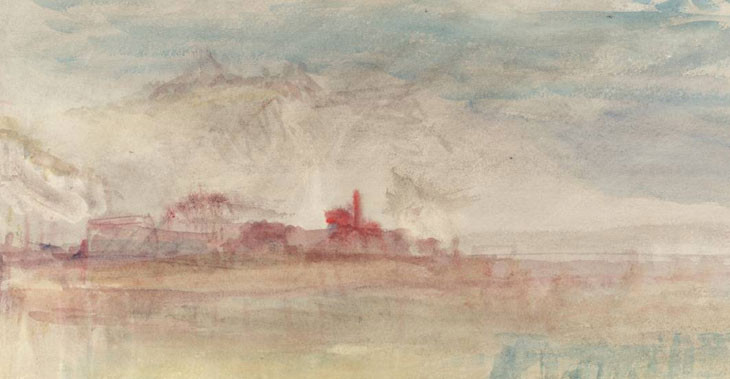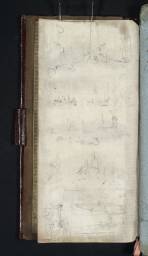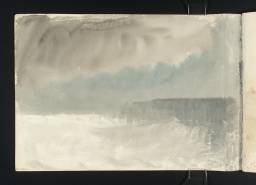The Kent Coast and Whaling c.1844–5

From the entry
Turner enjoyed a longstanding connection with Kent, having been sent to school at Margate on the North Foreland where Walter Thornbury writes that the artist ‘first saw the sea’ and ‘learnt the physiognomy of the waves’. These sketchbooks of the mid-1840s, then, constitute some of Turner’s later graphic exercises in the ‘physiognomy’ of the southern Kent coast: its headlands, beaches, harbours, and marine industries. Where Hythe and Walmer and Near Folkestone (?) sketchbooks are in the main comprised of rough pencil jottings of cliff profiles, shorelines and monuments, The Whalers and Ideas of Folkestone sketchbooks display Turner’s desire to evoke natural atmospheric effects through the use of colour. The principal medium employed is fluid watercolour pigment, used alone in transparent washes and gestural dry-brushstrokes in Ideas and in tandem with coloured chalks in Whalers. The Whalers sketchbook ...
Turner enjoyed a longstanding connection with Kent, having been sent to school at Margate on the North Foreland where Walter Thornbury writes that the artist ‘first saw the sea’ and ‘learnt the physiognomy of the waves’.1 These sketchbooks of the mid-1840s, then, constitute some of Turner’s later graphic exercises in the ‘physiognomy’ of the southern Kent coast: its headlands, beaches, harbours, and marine industries.
Where Hythe and Walmer and Near Folkestone (?) sketchbooks are in the main comprised of rough pencil jottings of cliff profiles, shorelines and monuments, The Whalers and Ideas of Folkestone sketchbooks display Turner’s desire to evoke natural atmospheric effects through the use of colour. The principal medium employed is fluid watercolour pigment, used alone in transparent washes and gestural dry-brushstrokes in Ideas and in tandem with coloured chalks in Whalers.
The Whalers sketchbook, traditionally believed to have been produced around 1844–5, features evocative watercolour and chalk depictions of the practice and processes of whale hunting. In addition, there are three unrelated drawings: two studies of a recumbent female nude and a sketch of a woman’s head. The whaling scenes are likely imagined, incorporating visual information Turner had observed directly or from his own research into domestic whaling fleets and the routines of processing carcasses such as burning blubber in bonfires on the shore.2
A similar handling and stylistic approach is found in The Ideas of Folkestone drawings, executed in 1845. With a distinct ‘economy of vision and execution’,3 Turner captures the atmosphere or the ‘idea’ of Folkestone rather than producing reproductive representations of the town. The drawings are rendered in broad applications of wash, the pigments often bleeding and feathering into one another, lending many of the scenes a suggestive and at times vaporous character. Landmarks such as the newly built Foord railway viaduct, the early nineteenth-century harbour, the Pent stream, and the Church of St Mary and St Eanswythe are featured.
Both The Whalers and Ideas of Folkestone sketchbooks are of a piece as regards handling and interpretation of the landscape with other sketchbooks attributed to 1845. These include the Ambleteuse and Wimereux, Boulogne, Eu and Tréport and Dieppe sketchbooks (Tate; Turner Bequest CCCLVII, CCCLVIII, CCCLIX, CCCLX). Between 1844 and 1845 Turner made three excursions to the Kent coast, combining stays there with what became his final trips to the Continent: Switzerland in 1844, Boulogne and its environs in May 1845 and Dieppe and Picardy in the autumn of the same year. The Kent ports of Folkestone and Margate were the points of departure for the cross-Channel steamer packets travelling to northern France. Margate was also where Turner’s companion late in life, Mrs Sophia Booth, had settled, her lodgings ‘overlooking Cold Harbour, between Custom House and the Foy Boat Inn’.4
The final two sketchbooks, Near Folkestone (?) and Hythe and Walmer, are comprised of rough pencil sketches. They are perhaps better described as graphic jottings or pictorial forms of note taking or shorthand. The former is a diminutive paper sketchbook designed for making quick sketches and records and to be kept in the pocket. The Hythe and Walmer sketchbook had a similar purpose, but takes the form of a pocketbook almanac in which rough sketches on loose pieces of paper were stored unfastened.
Near Folkestone (?) features various sketches of landmarks – some discernable, like Brighton Pavilion, and others less easily identifiable. The majority of the sketches depict profiles of coastal headlands and the towns atop them, shorelines and beaches, and historic monuments such as defensive forts or castles. Occasionally figures appear within these landscapes, offering glimpses of local life. The Hythe and Walmer sketchbook consists of similar pencil or pencil and chalk sketches, predominantly of cliffs and headlands taken by Turner whilst on foot or from a boat. There are also some very small isolated drawings of ships and boats as well as two intriguing sketches of parts of an unidentified town.
It is worth noting that the title attributed to the Hythe and Walmer sketchbook by A.J. Finberg may circumscribe or narrow the potential for the drawings to depict other sites beyond these towns and their environs. Finberg’s attribution is presumably based on two pencil inscriptions by Turner on separate sheets within the sketchbook which read ‘Walmer Castle’ (beneath a small sketch of this monument) and ‘Hythe’ (next to a sketch of a cliff) (Tate D35355, D35356). These notations, then, should not preclude the possibility that other locations on the Kent coast drawn at different times could also feature in this sketchbook or indeed in Near Folkestone (?). With Turner’s various excursions to the Kent coast and to northern France between 1844–5 in mind, deciphering the exact locations from which various immediately unidentifiable views were taken and their dates necessarily becomes more complex. Put simply, the sketchbooks could also integrate views of northern France as well as English Channel coastlines and towns.
Kent’s coastal terrain offered fruitful sketching grounds for Turner but these excursions probably also provided the artist with periods of respite during a time when he was known to have felt keenly the strains of work and responsibility at the Royal Academy. In 1845 Turner was serving on the Academy council, acting in lieu of the elderly and infirm President Sir Martin Archer Shee, while also serving on the hanging committee and producing his own works for exhibition. He lapsed in and out of ill health at this time, writing, in a letter to John James Ruskin on 15 May of that year of his weariness and malaise, and that he felt ‘obliged to go away from Town to revival by a little change of fresh air’.5
These sketchbooks also speak for Turner’s enduring artistic and sensory engagement with the sea: its swelling power during a storm, the tranquillity of it on a still morning, the light reflections upon its waters, and indeed man’s reliance on it for food, trade and transport. That Turner continued to be stimulated and inspired by marine and coastal views throughout his life is clear, but, as Tate curator David Brown points out, where earlier in his career Turner’s ‘eyes had ... been fixed mainly on the shore, and absorbed in its bustle and activity’, by the mid-1840s he preferred to ‘[look] out to sea across wet and lonely sands ... into the infinity of the “loveliest skies in Europe”.’6
Walter Thornbury, The Life of J.M.W. Turner, R.A. Founded on Letters and Papers Furnished by his Friends and Fellow-Academicians: A New Edition, Revised with 8 Coloured Illustrations after Turner’s Originals and 2 Woodcuts, London 1897, p.143.
How to cite
Alice Rylance-Watson, ‘The Kent Coast and Whaling c.1844–5’, February 2013, in David Blayney Brown (ed.), J.M.W. Turner: Sketchbooks, Drawings and Watercolours, Tate Research Publication, June 2013, https://www


